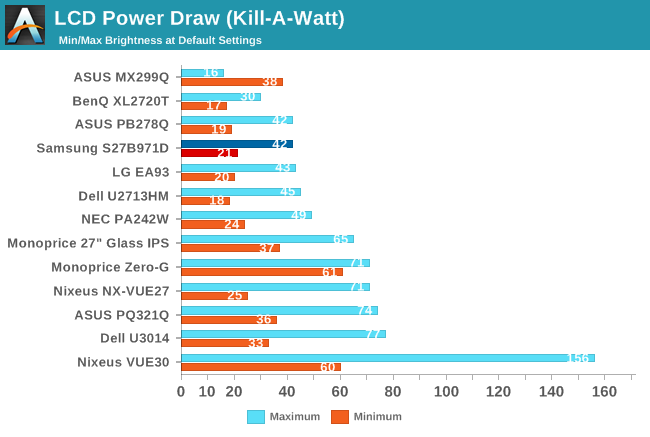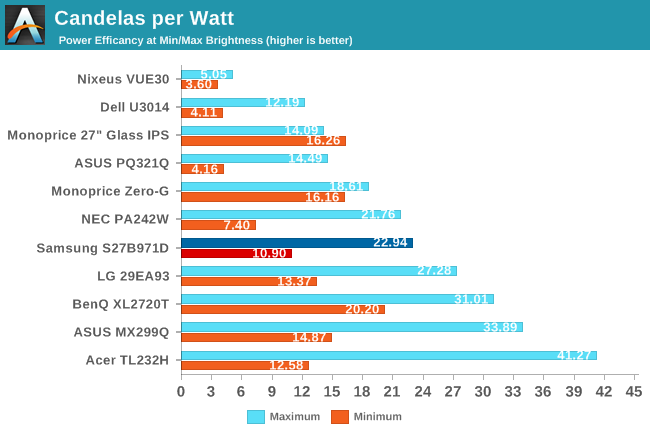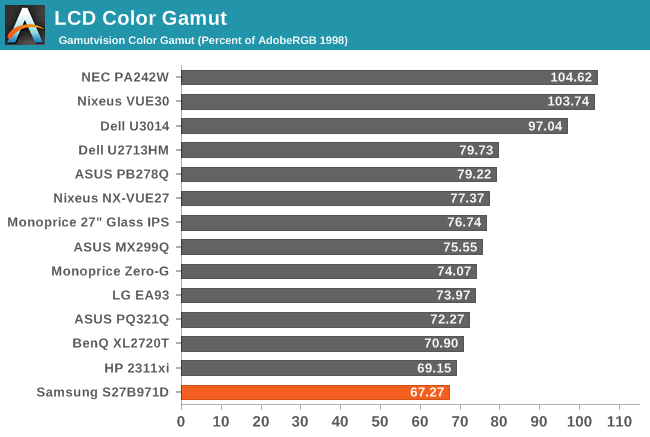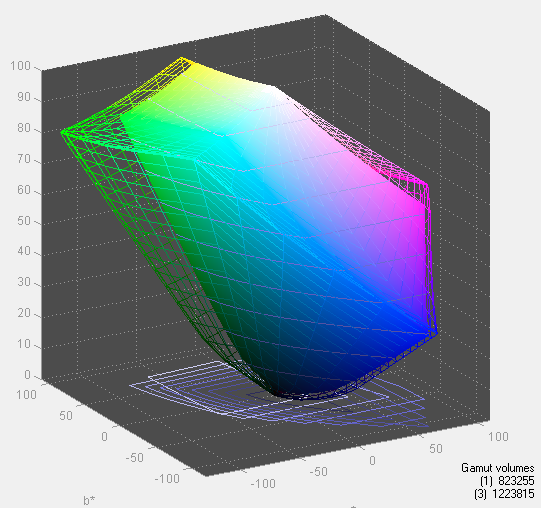Samsung S27B971D Monitor Review
by Chris Heinonen on October 31, 2013 12:00 PM ESTInput lag is tested over HDMI using the Leo Bodnar lag tester. It is limited to 1080p but it provides consistent, repeatable results that anyone can duplicate. A scaler can also be designed to introduce very little lag if implemented correctly so native resolution might provide better results, but it would be a slight difference (unless a poor/slow scaler is used).
Tested this way the Samsung S27B971D averages 26.3ms of lag. This is competitive with other 27” WQHD monitors that have produced 22.53 – 35.97ms of lag. Basically if you find any 27” WQHD monitor to be too slow, the Samsung won’t change your mind. I found nothing wrong with the overall gaming performance in my testing.

Power Use
Power draw from a Kill-A-Watt is reasonable on the Samsung with 21 watts at minimum backlight and 42 watts at maximum. On a candelas-per-square-inch-per-watt basis it comes in as being one of the most efficient monitors at maximum backlight and middle of the pack at minimum backlight. Now that virtually everyone uses LEDs, even for wide gamut displays, there probably won’t be as much difference here as there used to be.


Color Gamut
This is a bit interesting to me. In the sRGB mode the Samsung S27B971D falls short of the full sRGB gamut. It fills 67% of the AdobeRGB gamut, and not the 69% that we expect from sRGB. It’s a small difference but it is still a difference. If we switch to the standard color mode instead of sRGB then the gamut is larger. I ran the pre-calibration numbers, did a calibration in both modes, and ran the post-calibration numbers and found that the sRGB preset was far superior in the end. So while the gamut might come up just slightly low, it’s better than being over-saturated all around. In practice, very few people if any will notice the difference between 67% and 69%, as what we’re really looking for are displays that use significantly less than the sRGB gamut.












52 Comments
View All Comments
Alan G - Saturday, November 2, 2013 - link
Yes, writing to the monitor's LUT which is why NEC monitors are so easy to work with. I've used both their own Spectraview software or the ArgylCMS freeware to calibrate it. Of course the needs of photographers are quite different from those who game on their computer for which this monitor might be sufficient.Gothmoth - Saturday, November 2, 2013 - link
well EIZO or QUATO is the goto. but NEC spectravies are not bad below 2000 euro.bobbozzo - Friday, November 1, 2013 - link
Hi, please include the Aspect Ration on the specs chart on the first page of all monitor reviews.This one appears to be 16:9 :(
Thanks!
bobbozzo - Friday, November 1, 2013 - link
arg... Aspect Ratio!AnnonymousCoward - Friday, November 1, 2013 - link
30ms lag is unacceptable, and 67% gamut is bound to look dull next to a wide gamut playing any game. Too expensive, too.Gothmoth - Saturday, November 2, 2013 - link
test EIZO and QUATO monitors... why do you test all the dell and samsung consumer stuff but not the more pro oriented monitors out on the market?eizo CX240 or CX270... they are the competition to the NEC PA271 or PA272.
not these dell or samsung monitors.
cheinonen - Sunday, November 3, 2013 - link
As soon as Eizo or Quato will send me a display I'll test one. Until then I can't!hoboville - Monday, November 4, 2013 - link
Holy cow, I was thinking "Hmm this is a nice monitor, I've been wanting to get 1440p". Then I saw the price. What are they thinking?JakeLee - Tuesday, November 5, 2013 - link
Aren't you people aware that Samsung got caught cheating customers with fake calibration reports last year?Part 1: (partially English)
http://colormgmt.com/60166005864
Part 2: (Korean only)
http://colormgmt.com/60166308743
Samsung's excuse (Korean)
http://samsungtomorrow.com/2914
They admitted that the reports are "accidentally" misprinted, although the monitors are hand calibrated each through four stages.
It might be true, but Samsung has a very long list of shady practices....
cheinonen - Tuesday, November 5, 2013 - link
Thanks for posting that. I hadn't seen that before so it is good to see. That would certainly explain why the measurements on the included data sheet didn't match up to the performance I measured with CalMAN myself.